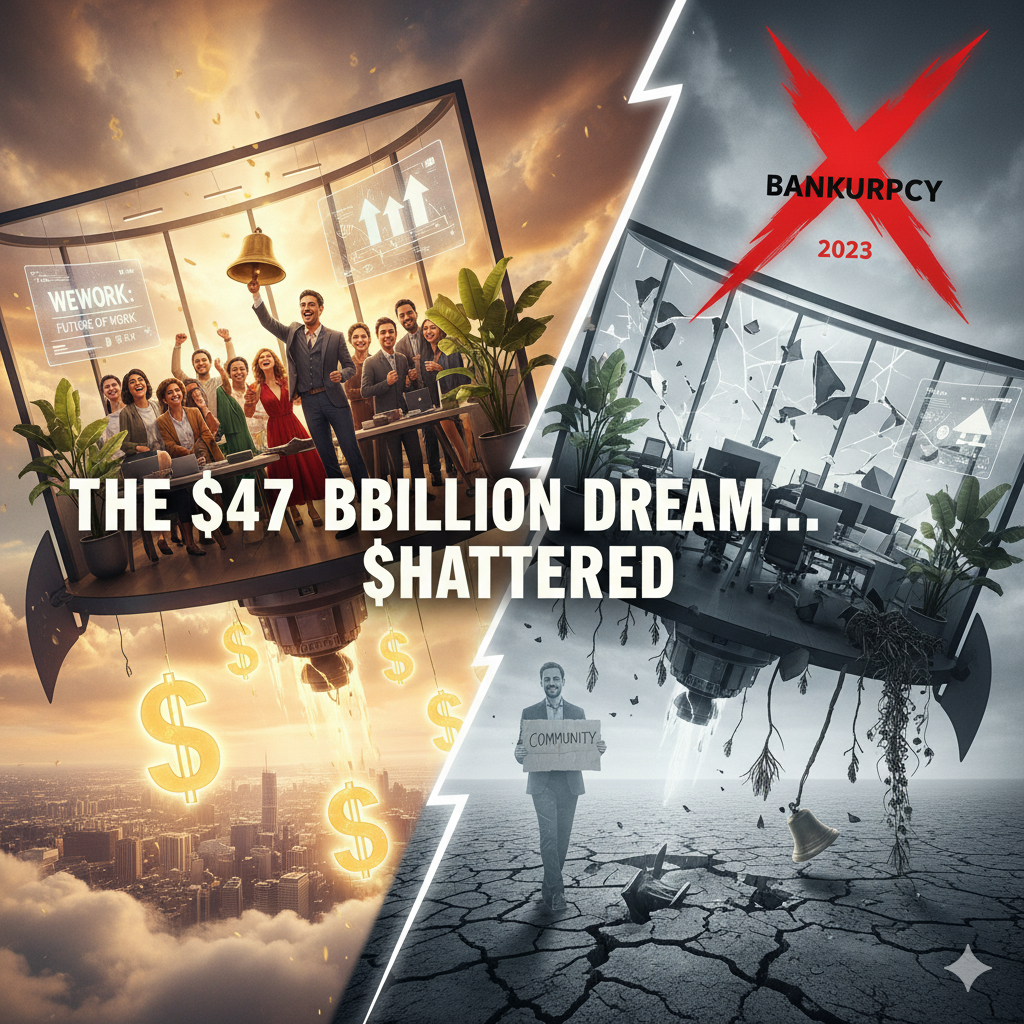How a Startup Valued at $47 Billion Crashed So Hard
Once hailed as the future of workspaces, WeWork was more than a coworking company—it was a global phenomenon. With its trendy offices, visionary messaging, and sky-high valuation, WeWork was expected to reshape how we work forever.
But within a year, the dream turned into a disaster.
From a $47 billion valuation to filing for bankruptcy in 2023, WeWork’s rise and fall is one of the most dramatic startup stories of our time. Here’s a simple, friendly breakdown of what happened—and why it matters to anyone curious about startups, business models, or just good old’ business drama.

The Big Idea: WeWork’s Vision for the Future of Work
WeWork started in 2010, founded by Adam Neumann and Miguel McKelvey. Their idea? Create flexible coworking spaces that felt more like creative communities than boring office rentals.
The brand wasn’t selling desks—it was selling a sense of belonging.
The company grew fast, backed by billions in venture capital, especially from SoftBank and its founder Masayoshi Son, who encouraged Neumann to “go bigger.” And bigger they went—expanding into We Live (co-living), We Grow (education), and a bunch of other offshoots. lets break it down what i researched and what we can learn from this:
How WeWork Became a $47 Billion Startup Unicorn
With each new funding round, WeWork’s valuation soared. At its peak, it was worth more than Airbnb or SpaceX. The company had locations in cities across the world, and being a WeWork member felt cool and modern.
Its marketing framed it as a tech company disrupting real estate, which helped attract even more investors. But while the vibe was exciting, the business model had serious cracks.

The Business Model Wasn’t Built to Last
On paper, WeWork’s idea looked modern and scalable:
Sign long-term leases on office buildings → renovate and redesign them → rent out short-term spaces to startups, freelancers, and enterprises.
But here’s the catch: WeWork didn’t own the real estate. It was just a middleman, locked into high fixed costs (those long-term leases) while hoping for variable, short-term revenue (desk rentals).
That’s risky in any industry—but especially in real estate, where:
Markets fluctuate.
Occupancy can fall.
Economic downturns hit hard.
Let’s say WeWork signed a 10-year lease for a building at ₹5 crore per year. Even if only 40% of the desks were filled, they still had to pay that ₹5 crore annually.
And unlike traditional landlords, WeWork was responsible for furnishing, staffing, events, and maintenance, which added even more to their costs.
- The Unit Economics Were Upside Down
In simpler terms:
“The more they expanded, the more money they lost.”
That’s not how a business should work.
Each new location took millions to set up, and it would take years just to break even—if it ever did. Plus, they spent a ton on perks, marketing, and creating a “lifestyle brand,” which may have looked cool but didn’t help profits.
Compare this to Airbnb or Uber—other fast-growing startups that also scaled quickly. The difference?
Airbnb didn’t own the homes.
Uber didn’t own the cars.
WeWork, on the other hand, took on massive liabilities with every lease.
And Then There’s Flexibility vs. Responsibility
WeWork offered short-term, cancel-anytime leases to tenants… but had no such flexibility on the other side. Their landlords weren’t offering month-to-month deals. This mismatch is called a “duration mismatch,” and it’s deadly when the market shifts or demand slows down (like it did during COVID).

The IPO That Exposed Everything
In 2019, WeWork decided to go public. That meant they had to share their financials with the world—how much they earned, how much they spent, and how things really looked behind the scenes.
And… it wasn’t pretty.
The numbers showed massive losses. The company was spending way more than it was making.
Then came the red flags:
Adam Neumann had already cashed out a huge amount of money—before the IPO even happened.
He was renting out buildings he personally owned… to WeWork. Yes, the company was paying rent to its own CEO.
On top of that, the company seemed to run more on Neumann’s personality than solid business rules. People started calling it a “cult of personality.”
As soon as all this came out, investors panicked. The media ripped it apart. The IPO was canceled. WeWork’s value dropped like a rock. And Neumann? He stepped down—but walked away with a jaw-dropping $1.7 billion exit deal.
What We All Can Take Away from the WeWork Story
Looking back, it’s easy to wonder—how did no one see this coming?
But the truth is, when you’re caught up in the excitement of a big idea, it’s hard to notice the cracks forming underneath. WeWork felt like a rocket ship, and when something is growing that fast, people often assume it’s unstoppable.
Still, there are some things that stand out once the dust has settled:
Big Growth Doesn’t Fix a Broken Model
WeWork kept opening new locations at lightning speed, even though many of them weren’t making money. The logic seemed to be: if we just get big enough, it’ll all work out. But in reality, growing a shaky model just makes the problems grow with it.
Sometimes, staying small while you fix the basics is the smarter move. Scaling comes later. its true for every thing in life not only in business .

Charisma alone Isn’t a Business Plan
Adam Neumann could sell a dream better than most founders. He had charm, energy, and bold ideas. But that’s only one piece of the puzzle. A business also needs boring stuff: solid numbers, checks and balances, and people who aren’t afraid to say “this doesn’t make sense.”
In WeWork’s case, the storytelling was powerful—but it was missing structure behind the scenes.

Paper Valuations Can Disappear Overnight
At one point, WeWork was “worth” $47 billion—at least on paper. But when reality hit, that number meant nothing. Valuation is just an investor’s best guess. It’s not the same as having a business that actually earns money or runs efficiently.
So whether you’re a founder or just fascinated by startups, it’s worth asking: Is this company valuable, or just hyped?

One last thing that often gets missed—WeWork’s original idea wasn’t bad. Flexible office space is still a great concept. The failure wasn’t the product—it was how the business was run. Too fast, too flashy, and too focused on image over infrastructure.
In the end, WeWork became a cautionary tale not because it dreamed big—but because it didn’t know when to pause, question itself, and rebuild what wasn’t working. And honestly, that’s a lesson a lot of us can relate to—whether you’re building a business, chasing a goal, or just figuring things out.

